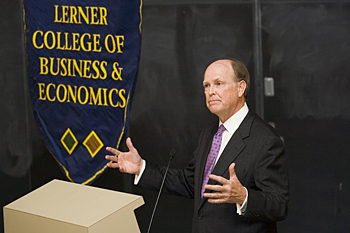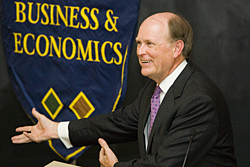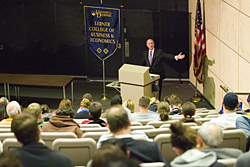
Addressing a near-capacity audience of students, professors and media, the guest speaker at this year's Hutchinson Lecture said the Federal Reserve can best achieve its objectives by making credible commitments.
“The Federal Reserve as the monetary authority has a mandate to provide a stable price level and promote maximum sustainable growth,” Plosser said. “These are important goals that can contribute to a more efficiently functioning economy and thus help to promote higher living standards. So the question becomes: How can the Federal Reserve System best go about achieving these goals? I am going to address one critical element of the Fed's ability to achieve its objectives--the importance of making credible commitments.”
While making a commitment means a policymaker would follow through on a promise regarding future actions, Plosser said a policymaker's use of discretion, meaning the policy maker is not compelled to keep promises and is able to act independently, can have economic implications.
“The temptation to renege on previous promises or plans is what economists refer to as the time-inconsistency problem, and it has surprisingly troublesome consequences,” he said. “In particular, it can mean that outcomes under a discretionary regime are likely to be worse than those under a regime where the policymaker is constrained to follow through on previous commitments.”
Using patents as an example, Plosser explained that governments often give patents, or “temporary monopoly rights” to those who develop new products to ensure an adequate return on projects, which may be both expensive and risky. But a policymaker also can rescind patents to make the product available to everyone, Plosser said, resulting in more competition, lower prices and financial losses for inventers.
“In this case, the policymaker is acting in a way that is conditioned on previous outcomes and that may appear, at the time, to be optimal for society as a whole,” he said. “But I think you can all see that such change in policy, while having short-term benefits, is likely to have devastating effects on future investments in research and inventive activity. In particular, since the potential returns to innovation might well vanish at the discretion of the policymaker, the incentive to invest in risky research will fall.”Citing past inflation rates, Plosser said former chairmen of the Federal Reserve, such as Alan Greenspan, have struggled to maintain credibility with the public while committing to lower inflation rates. “The uncertainty over the Fed's desire to contain inflation, which is a feature of an economic environment where full commitment is impossible, has costs,” he said. “To the extent that a monetary authority can build a reputation and gain credibility for low inflation, it helps to ameliorate this uncertainty and produces tangible economic benefits.”
Plosser said the Fed clearly states its objectives of monetary policy as a way to diminish the public's uncertainty about its policies and goals. The Fed announces policy moves, issues policy statements and releases meeting minutes, he said, to help maintain its credibility regarding issues such as lowering inflation.
“Suffice it to say that there is a realization in monetary policymaking circles, gained through recent advances in monetary theory and the experience of the last 30 years, that maintaining credibility for low inflation is an important aspect of good monetary policy,” he said. “Furthermore, it is important to be transparent so that the public's expectations and the objectives of monetary policy are better aligned. Achieving this alignment ultimately furthers the central bank's objective of maintaining stable prices while fostering full employment.”
Plosser became the 10th president of the Federal Reserve Bank of Philadelphia in August. He previously was the John M. Olin Distinguished Professor of Economics and Public Policy and director of the Bradley Policy Research Center at the William E. Simon Graduate School of Business Administration at the University of Rochester, where he also served as dean from 1993-2003.
Plosser, who has authored many academic articles, received his doctorate and master's degree in business administration from the_University of Chicago and earned a bachelor's degree in engineering with honors at Vanderbilt University.

The Hutchinson Lecture series was established in 1990 to honor the distinguished academic career of the late Harry D. Hutchinson, a professor of economics who taught at UD from 1959-89. Hutchinson received his doctoral degree in economics from the University of Michigan and worked at UD until his retirement. His career was distinguished by excellence in teaching and scholarship and his textbook, Money, Banking & The U.S. Economy, was the foundation for many students' introduction to financial institutions. Hutchinson died on July 28, 2005.
The lecture was sponsored by the Department of Economics in UD's Alfred Lerner College of Business and Economics.
Article by Julia Parmley, AS '07
Photos by Kevin Quinlan



